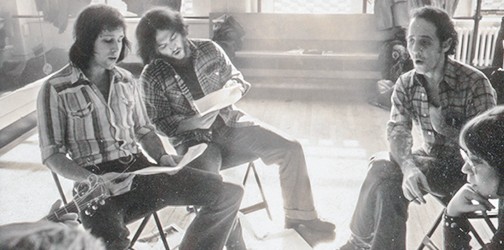Cinema | October 8th, 2015

As the most likely audience members of “Drunk Stoned Brilliant Dead,” hardcore National Lampoon fans of a certain age are the choirboys and choirgirls to filmmaker Douglas Tirola’s preacher.
Tracing the history of the magazine and its prolific mediated spinoffs, Tirola’s film at least scratches the surface of the rise and fall of the Lampoon empire, even if a comprehensive account couldn’t possibly fit in a single feature movie. Cramming together dozens of interviews, hundreds of illustrations and photographs, and seemingly thousands of scattershot thoughts, the documentary works best as a rough introduction to the anything-goes, decidedly politically incorrect worldview of the publication’s key personnel – most notably cofounders Henry Beard and Doug Kenney.
Beyond Beard and Kenney, Tirola struggles to keep straight for the viewer the many players and their roles, prominently featuring obvious personalities like Michael O’Donoghue and John Belushi while leaving others unexplored. Many key participants are introduced, but the breadth-over-depth tactic results in fleeting glimpses that will leave many viewers craving details on the volatile relationship dynamics that resulted from the dangerous cocktail of youth, ambition, intelligence, lust, and the consumption of mountains of drugs and oceans of alcohol.
National Lampoon’s sensational art direction, realized through scores of parody advertisements (like the floating VW Beetle image referencing Chappaquiddick), cartoons and illustrations (including work by Arnold Roth and Neal Adams), and a parade of unforgettable cover images (from the scathing William Calley/Alfred E. Neuman mashup “What, My Lai?” to Ed Bluestone’s iconic “If You Don’t Buy This Magazine, We’ll Kill This Dog”) begs to be the subject of its very own feature documentary, but Tirola shows as much as possible, blasting through one eye-popping snapshot after another. Fortunately, Michael C. Gross, who did more than any single person to shape the look and sensibility of the magazine’s graphic identity, is on hand as an important guide.
The distance of time illuminates some of the magazine’s less savory white male personality traits, from brutal misogyny to ugly racism (even when the intention is for the jokes to be on racists). Disappointingly, Tirola elects to gloss over these issues when some critique on the philosophy and evolution of comedy is sorely needed. When, for example, Anne Beatts shares a joke about getting into comedy the way Catherine the Great got into politics, the moment passes without any of the important context framing the conditions faced by the women who participated in a culture notorious for its regressive attitudes and practices. A shrug and a wink are pretty cold comfort.
Not surprisingly, Tirola devotes a considerable amount of time to the exploration of National Lampoon’s widest “superstar” breakthrough: the unexpected success of “Animal House.” Many of the personalities associated with the movie discuss its genesis and burnish its legendary influence on an entire genre.
The siren song of Hollywood dollars, not to mention the routine poaching of Lampoon talent by Lorne Michaels for “Saturday Night Live,” directly contributed to the decline and eventual demise of the magazine, and this partial explanation hovers over the later sections of the movie. The party and the story really end with the mysterious and much-debated death of Kenney, briefly memorialized on camera by friend Chevy Chase in a grim yet heartfelt lightning bolt of black comedy.
"Drunk Stoned Brilliant Dead" premiered at the Sundance Film Festival and is now available theatrically in select cities and on iTunes.
December 29th 2025
December 29th 2025
December 16th 2025
December 9th 2025
December 2nd 2025


__293px-wide.jpg)
_(1)_(1)_(1)__293px-wide.jpg)
_(1)__293px-wide.png)
_(1)__293px-wide.jpg)